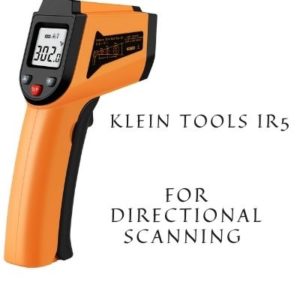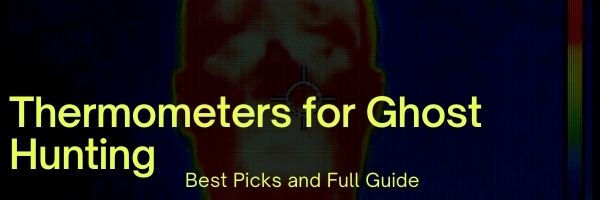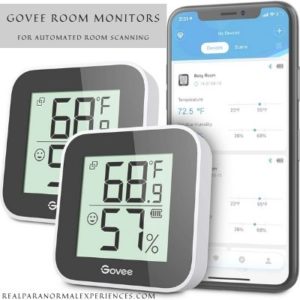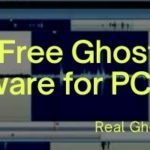Table of Contents
One of the original tools of paranormal investigators (before we started getting specialized equipment) was a thermometer. We’ve spotted spot cold spots and heat spikes caused by ghosts and paranormal entities and I thought I’d do a quick rundown of how to use a thermometer for ghost hunting and my suggestions for your kit.
Let’s look at why we use them, how we use them and what ones will help you find ghosts.
Why and How Ghost Hunters Use a Thermometer
Almost every Hollywood horror movie has that cold spot in a room or warm breath on a cheek. For once, Hollywood isn’t entirely far from the truth here. I’ve talked about paranormal warm spots (and what causes them) but judging temperature changes with our skin isn’t exactly accurate.
Paranormal investigators will often use a digital thermometer (or an infrared one) in a room to detect if the temperature rises or falls quickly. Sometimes a sharp drop can tell us a ghost has entered the room and we can reach out with a spirit box or use a thermal camera to look for the ghost.
The main uses I see on ghost hunting sessions are:
- Setting a thermometer up in a room to tell us when a ghost enters.
- Moving a thermometer between rooms looking for rooms that vary from the ambient temperature.
- Multiple set up in a room to watch the air temperature in different spots.
Will a Simple Thermometer Work for Ghost Hunting?
The old-school glass and mercury thermometers can work but they’re not ideal. Hollywood movies will show one on the wall drop quickly for dramatic effect but the reality is these temperature changes can come quickly and these older ones are unlikely to be that useful.
Basically, if you have nothing else go for it but they won’t be accurate enough for the most part. You don’t need anything too complicated either, but I’ll show you my suggestions.
Best Thermometers for Ghost Hunting
There’s a couple of things I’d look for in a thermometer and a whole lot of useless features I would stay very far away from. They’ll just drive up the price and add nothing to your investigations so don’t pay extra for something you don’t need.
For ghost hunting there’s only a couple of things you really need to look for:
- Non-contact.
- Update speed.
- Decent range.
- Good temperature range.
With that in mind these are the ones I’d suggest including in your kit:
Klein Tools IR5 Dual Laser 12:1 Infrared Thermometer

Perfect for a cold-spot detector it sweeps an area pretty quickly and the laser grid paints the area for you so you don’t miss anything.
Easily my #1 pick for the beginner or professional paranormal investigator. The only drawback you might run into is it focuses on an area and not an entire room. For the most part, this is enough but there are some occasions you’ll want to watch for changes in a room and not just a specific area.
For those situations, I use a different device:
Govee Temperature Humidity Monitor for Rooms
This two-pack of non-directional thermometers can be set up to watch different rooms of a house and connects to an app on your phone.
Easy to set up, these are perfect for ghost hunting as they not only alert in real-time for temperature changes but they’ll store historic data. Even a professional ghost hunter is going to miss things, especially if you’re busy dealing with other equipment, so this is a handy feature.
An essential tool if you’re trying to watch multiple rooms in a house but if you’re picking between the two, go with the first directional IR thermometer for more flexibility.
Setting Up a Thermometer for Ghost Hunting
No ghost hunter worth their salt will use temperature changes alone to confirm ghostly encounters but they’re often one of the first things we set up when beginning a session.
Outdoors
I’ll often use a directional IR thermometer to scan an area looking for fluctuations. Either hot or cold spots and once something stands out we’ll use other equipment to confirm and try and establish contact.
Obviously, watch out for environmental conditions. You might be surprised how long heat from the sun will hold in gravestones (for example) but you’ll learn how to avoid false positives and spot when there’s a temperature fluctuation that doesn’t make sense.
Indoors
Indoors, it really depends on what you’re doing.
If you’re sweeping somewhere, I’d still go with the directional IR device. Set it to alert on fluctuations and slowly sweep rooms making sure you cover everywhere (yes, that means pointing it above you too).
If you’re watching multiple rooms and waiting for a ghost to show up then I prefer using the room monitors. Often I’ll watch the room I’m in with EMF meters and leave the thermometers watching different rooms. If they alert to temperature spikes, you can follow up in those rooms with other equipment.
Obsessed by ghost hunting and all things paranormal. Chris spends a lot of time (some would say too much time) investigating ghosts and spirits and documenting stories and paranormal communication. He teaches aspiring ghost hunters in the Paranormal Academy.









![Thermal Camera for Ghost Hunting [Complete Guide] Thermal Camera for Ghost Hunting [Complete Guide]](https://realparanormalexperiences.com/wp-content/uploads/2021/06/Thermal-Camera-for-Ghost-Hunting-150x150.jpg)

![SLS Camera for Ghost Hunting [Ultimate Guide] SLS Camera for Ghost Hunting [Ultimate Guide]](https://realparanormalexperiences.com/wp-content/uploads/2021/06/SLS-Camera-for-Ghost-Hunting-1-150x150.jpg)